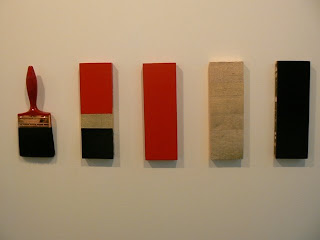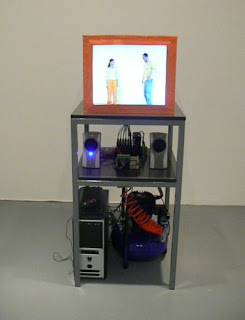






The advantage of the Sharjah Biennale is that it’s there for long enough to take a leisurely look at although I’m not sure how much human traffic it gets once the frenzy of the opening week is done. That said I was loitering suspiciously in Sharjah last Saturday and there were quite a lot of visitors going in and out of the Sharjah Art Museum.
This is just one of the Biennale venues but contains the most work in one place. It is also an amazing building. It has sloping floors which make walking around a slightly disconcerting experience a bit like being in one of those optical illusion prints by Escher of never-ending staircases. This architectural feature is actually used by two of the artists. Ayse Erkmen created a false room with the lights hanging at an angle. However, because you are viewing it from an angle it seems as if the false room is the one with the correct proportions. Karin Sander created a track around two corridors along which a chrome ball can run simply because of the downward slope of the floor. The only problem with this is that someone needs to switch the ball onto the other side of the circuit when it reaches the bottom so that it is in constant motion. I have been there several times now and not once have I seen this happen. I guess not all the security guys were told that this was part of the job!
There is a lot of stuff to see and you really do need time especially to check out all the video work. Liu Wei’s Hopeless Lands is a short and disturbing video about Chinese farmers who now eke out a living from urban trash. Seeing hundreds of people swarming around the back of a lorry as it spills its contents onto a massive dump site is an image that will stay with me for some time. By contrast Liliana Porter’s Fox in the Mirror, in which music is played by an orchestra of ceramic, plastic and wax figures, was a lot of fun. Definitely a dark edge to it but overall highly entertaining. Not sure what Zebra by Haris Epaminonda was about other than spectrum but enjoyed the constant drifting refrain of Bach’s Prelude to Cello Suite No. 1 in G Minor. Actually the only thing the visual aspect of this work brought to my mind was an ink jet printer commercial but I guess I missed something.
Fernando Jose Pereira’s, Remote Control-Remove Control in its own reconstructed Icelandic hut ended up being less interesting than it sounded. That was actually the case with several other works. The concepts and ideas underpinning them ended up seeming more impressive than the work itself. That said it was nice to briefly feel the icy chill of an Icelandic day in the middle of Sharjah!
This is just one of the Biennale venues but contains the most work in one place. It is also an amazing building. It has sloping floors which make walking around a slightly disconcerting experience a bit like being in one of those optical illusion prints by Escher of never-ending staircases. This architectural feature is actually used by two of the artists. Ayse Erkmen created a false room with the lights hanging at an angle. However, because you are viewing it from an angle it seems as if the false room is the one with the correct proportions. Karin Sander created a track around two corridors along which a chrome ball can run simply because of the downward slope of the floor. The only problem with this is that someone needs to switch the ball onto the other side of the circuit when it reaches the bottom so that it is in constant motion. I have been there several times now and not once have I seen this happen. I guess not all the security guys were told that this was part of the job!
There is a lot of stuff to see and you really do need time especially to check out all the video work. Liu Wei’s Hopeless Lands is a short and disturbing video about Chinese farmers who now eke out a living from urban trash. Seeing hundreds of people swarming around the back of a lorry as it spills its contents onto a massive dump site is an image that will stay with me for some time. By contrast Liliana Porter’s Fox in the Mirror, in which music is played by an orchestra of ceramic, plastic and wax figures, was a lot of fun. Definitely a dark edge to it but overall highly entertaining. Not sure what Zebra by Haris Epaminonda was about other than spectrum but enjoyed the constant drifting refrain of Bach’s Prelude to Cello Suite No. 1 in G Minor. Actually the only thing the visual aspect of this work brought to my mind was an ink jet printer commercial but I guess I missed something.
Fernando Jose Pereira’s, Remote Control-Remove Control in its own reconstructed Icelandic hut ended up being less interesting than it sounded. That was actually the case with several other works. The concepts and ideas underpinning them ended up seeming more impressive than the work itself. That said it was nice to briefly feel the icy chill of an Icelandic day in the middle of Sharjah!
Basma Al Sharif’s video We began by measuring distance received one of the Biennale artist prizes. Unfortunately, I haven’t actually seen it all the way through yet so can’t comment but it’s reserved for a complete and slow viewing next time I’m down there along with Primoz and Novak’s fictional documentary Going South and Ghani and Kelly’s, Smile you’re in Sharjah.
Over the road in the Serkal House are videos by Sharif Waked and Nikolaj Larsen. Waked uses the now familiar media image of a suicide bomber’s last broadcast but his protagonist reads excerpts from One Thousand and One Nights thus avoiding the usual horrific denouement. This mirrors the origin of the tales themselves in which Scheherazade narrates one tale after another to King Shahrayar in order to save herself and her tribe from execution. It is quite mesmerizing listening to the tales and very frustrating when suddenly the tale switches and you don’t get to hear the end.
Nikolaj Larsen’s work consists of two videos projected onto facing screens. On one screen Indian migrant workers based in Sharjah stand staring into the camera. On the opposite screen their families back in India do the same. Watching these simultaneous screenings in the space between, where the viewer can see both but they can’t see each other, was a very intimate and actually very moving experience. I cannot recall having been moved to tears by a video installation before! Maybe it was just one of those days.
I reviewed the biennial for a US arts website (here: Absolute Arts) but other things that stood out that I haven’t mentioned elsewhere were a room full of Robert Macpherson’s assorted work, Yonamine's sandbag installation and Hiroyuki Masuyama’s light boxes. Nadia Kaabi Linke’s hanging paint fragments making a map of the UAE cast beautiful shadows on the surrounding walls and Hayv Kahraman’s meticulously composed Domesticated Marionettes were also perfectly placed for maximum impact in their big space in the Serkal House.
The overall mix of mediums, styles, concepts, materials and spaces means that there is probably something for everyone here, even if you don't have much time, and the kids will love The Box!
One other observation though is maintenance. Admittedly keeping all this going for two months is difficult. It’s not just hanging pictures on a wall and leaving them there! So expect a few un-replaced light bulbs on certain installations, the odd lack of transmission on headphones and no doubt a few other mechanical and technical hitches to come before May 16th!
Whatever…. Just GO! You’ve got over a month ….

hi,
ReplyDeleteit was great to read your review. i work at the Sharjah Art Musseum and it's always a good thing when we get to hear first hand from our visitors about their trip to the museum.
hope to see you again in the future. do let me know if you need anything.
Glad you enjoyed it!
ReplyDeleteNice overview !
ReplyDeleteCould you add me to your mailing list, please ?
dennisandersongallery@yahoo.com
or
http://www.facebook.com/friends/?everyone&ref=tn&nctrct=1239620482130#/home.php?ref=home
Thank you !
opps..think you just caught another fan. pls link me azlizaayob@gmail.com
ReplyDeleteor u could enjoy some of my artworks at tumpangtravels.blogspot.com
regards!